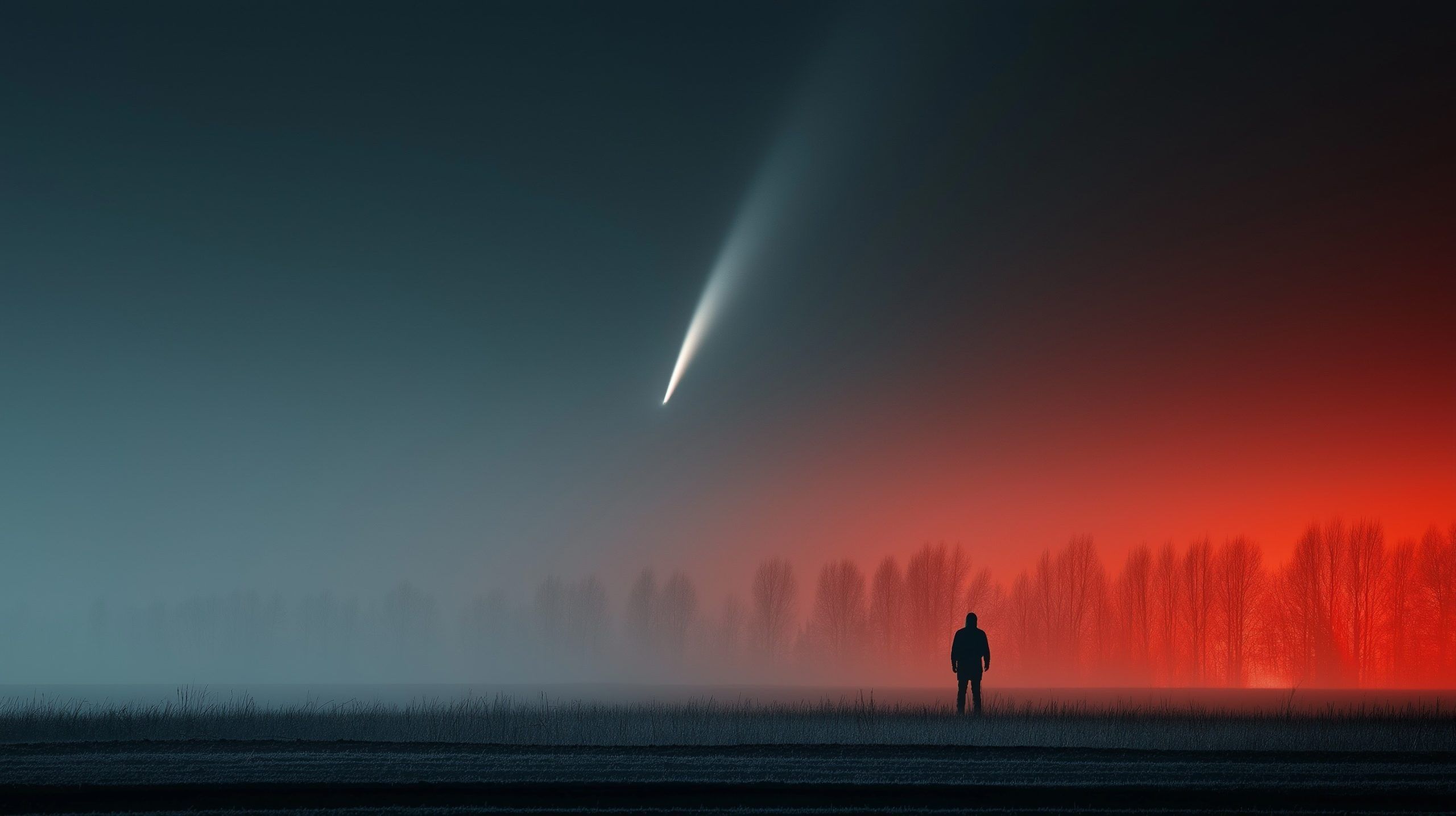- Perseids peak on August 12–13, 2025 with 50–100 meteors per hour in the Northern Hemisphere, best after midnight as the Moon wanes.
- Geminids peak on December 13–14, 2025 with 100+ meteors per hour and the first-quarter Moon sets early.
- Quadrantids peak on January 3–4, 2026 with about 120 meteors per hour over roughly a four-hour window, aided by new Moon darkness.
- Total lunar eclipse on September 7–8, 2025, the long-haul Blood Moon, fully visible across Europe, Africa, Asia and Australia/New Zealand with totality about 1 hour 22 minutes.
- Saturn at opposition on September 21, 2025; rings are edge-on for a photogenic but slightly dimmer view, magnitude about 0.6 all night.
- Neptune at opposition on September 23, 2025; magnitude 7.8 with a blue disk in Pisces, a telescope challenge.
- Uranus at opposition on November 21, 2025; magnitude 5.6, a small greenish disk accessible with binoculars under dark skies.
- Jupiter at opposition on January 10, 2026; magnitude −2.8 and visible all night in Gemini.
- Annular solar eclipse on February 17, 2026; central path crosses Antarctica and the southern oceans, with more than 60% partial over southern Africa and South America at sunrise.
- Total lunar eclipse on March 2–3, 2026; prime-time for Western North America and the Pacific, with the last total until 2028–29.
Executive snapshot
From a New Zealand sunrise eclipse in September 2025 to a fiery “ring of fire” annular eclipse over southern Africa in February 2026, plus two total “Blood-Moon” eclipses, four outer-planet oppositions, the reliable Perseids and Geminids, and a newly discovered comet (C/2025 L1 ATLAS) brightening next spring—this 12-month stretch is packed with reasons to stay up late or rise at dawn. Below you’ll find a month-by-month deep dive, complete with best-viewing tips, global visibility notes, and key science facts.
How to use this guide
- Times are stated in UTC; add +2 h for Central European Summer Time (Poland) or adjust to your locale.
- Visibility codes: (G)=global, (N/S/E/W Hem)=best hemisphere, (Loc)=regional.
- Gear: Naked-eye events are marked ★; binocular/telescope suggested ✦.
Month-by-month calendar
JULY 2025
| Date | Event | Details & Visibility |
|---|---|---|
| 22 Jul | ★ Southern δ-Aquariids begin | Early activity; peak late July; best after midnight in the tropics. Timeanddate |
| 30 Jul | ✦ Mercury greatest elongation W | Morning sky, 20° from Sun; fine binocular target in E at dawn. In The Sky |
AUGUST 2025
| 12–13 Aug | ★ Perseid meteor shower peak | 50–100 meteors/hr in N. Hemisphere; Moon a waning gibbous rises late, so catch the post-midnight burst. Timeanddate |
| 19–21 Aug | ✦ Mercury at highest morning altitude & dichotomy | Excellent naked-eye apparition in the dawn east. In The Sky |
SEPTEMBER 2025
| 7–8 Sep | ★ Total lunar eclipse (“long-haul Blood Moon”) | Entirely visible across Europe, Africa, Asia & Aus/NZ; totality ~1 h 22 m. Timeanddate |
| 21 Sep (22 Sep local NZ) | ★ Partial solar eclipse | Greatest obscuration (40 %) at sunrise in New Zealand; also skims E-Australia, Pacific isles, Antarctica. Eye protection mandatory. Timeanddate |
| 21 Sep | ✦ Saturn at opposition | Rings edge-on year—photogenic but dimmer; planet shines mag 0.6 all night. Timeanddate |
| 23 Sep | ✦ Neptune at opposition | Telescope challenge at mag 7.8, blue disk in Pisces. Timeanddate |
OCTOBER 2025
| 8–9 Oct | ★ Draconid “flash” shower | Unpredictable outbursts; radiant high for N-Europe just after dusk. Timeanddate |
| 21–22 Oct | ★ Orionids | 15–25 meteors/hr before dawn; debris of Halley’s Comet. Timeanddate |
| Late Oct | ✦ <u>Five-planet evening line-up</u> | Mercury, Venus, Mars, Saturn, Jupiter strung across dusk sky—excellent public-outreach photo op.
NOVEMBER 2025
| 16–18 Nov | ★ Leonids | 10–15 meteors/hr; thin crescent Moon yields dark skies. Timeanddate |
| 21 Nov | ✦ Uranus at opposition | Small greenish disk (mag 5.6) in Aries; binocular-easy under dark skies. Timeanddate |
DECEMBER 2025
| 13–14 Dec | ★ Geminids | Year’s best shower, 100+ meteors/hr; first-quarter Moon sets early. Timeanddate |
| 22–23 Dec | ★ Ursids | Bonus high-latitude shower (5–10 meteors/hr) peaking near the solstice with a dark Moon. Timeanddate |
JANUARY 2026
| 3–4 Jan | ★ Quadrantids | Intense 4-hour peak (~120 meteors/hr) before dawn; new-Moon darkness. Timeanddate Timeanddate |
| 6 Jan | ✦ Venus at superior conjunction | Lost in solar glare; re-emerges in February’s evening sky. In The Sky |
| 10 Jan | ✦ Jupiter at opposition | Giant planet beams at mag –2.8, visible all night in Gemini. In The Sky |
FEBRUARY 2026
| 17 Feb | ★ Annular (“ring of fire”) solar eclipse | Central path crosses Antarctica & the southern seas; >60 % partial over S-Africa & S-America sunrise. Timeanddate |
| 23 Feb | ✦ Venus–Mars close pass (0.4°) in evening twilight—great binocular pairing.
MARCH 2026
| 2–3 Mar | ★ Total lunar eclipse | Prime-time for W-North America & Pacific; partial phases visible across E-Europe pre-dawn. Last total until 2028-29. Timeanddate |
| Mid-Mar | ✦ Comet C/2025 L1 (ATLAS) | Predicted mag 13, brightening enough for medium telescopes as it nears 1.68 AU perihelion (12 Jan 2026) and best Earth distance in March. Theskylive |
APRIL 2026
| 22–23 Apr | ★ Lyrid meteor shower | 15–20 meteors/hr; radiant rises after midnight; full-Moon phase does not interfere (waning gibbous sets pre-dawn this year). Timeanddate Astropixels |
| 24 Apr | ✦ Venus–Uranus conjunction (0.8°) in Aries; photograph Venus guiding to faint Uranus. In The Sky |
MAY 2026
| 5–6 May | ★ Eta-Aquariids | 40–50 meteors/hr, spectacular in Southern Hemisphere dawn sky; slim waning crescent. Timeanddate |
| Late May | ★ Tau Herculids / 73P-ids (possible outburst) | Linked to comet 73P; watch around 31 May for surprise storm. Cosmobc |
JUNE 2026
| 4 Jun | ✦ Mercury greatest elongation E | Best evening apparition of the year for N-Hem observers. |
| 27 Jun | ★ June Boötids | Usually minor (1–2 meteors/hr) but historically capable of huge outbursts—worth monitoring under moonless skies. Wikipedia |
Ongoing sky treats (any clear night)
- Milky Way core: Splendid in southern sky from May–August nights.
- Zodiacal light: Look for the pyramid-shaped glow before dawn in late September–October and after dusk in late February–March at mid-latitudes.
- ISS passes & Starlink trains: Use an app for real-time timings.
Anticipated comets & “wildcards”
| Comet | Best window | Notes |
|---|---|---|
| C/2025 L1 ATLAS | Nov 2025 – Apr 2026 | Could crest mag 12–13; circumpolar for N-latitudes in late winter. Theskylive |
| C/2025 F2 SWAN | Late 2025 | Likely stays ~mag 14 (large telescope). Theskylive |
| C/2025 J1 Borisov | Jun 2026 perihelion (3.6 AU) | Faint, but interstellar discoverer Gennadiy Borisov’s next gem—monitor with CCD rigs. Theskylive |
Observing tips
- Dark skies: Get 40 km from city lights whenever possible.
- Moon phase matters: Use this list to plan meteor watching around new- or crescent-Moon dates.
- Safety first: For all solar eclipses, use ISO 12312-2 certified filters or indirect projection.
- Log your observations: Citizen-science networks (IMO, AAVSO) welcome timing, brightness, and photo data.
Clear skies and happy hunting—mark your calendars now so July 2025 through June 2026 becomes your most memorable astronomy year yet!




